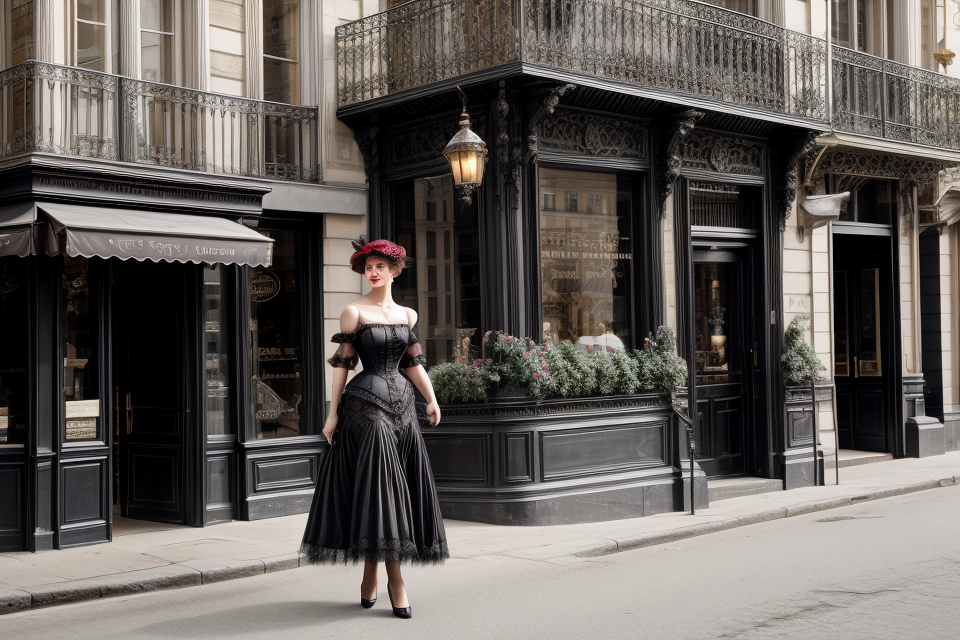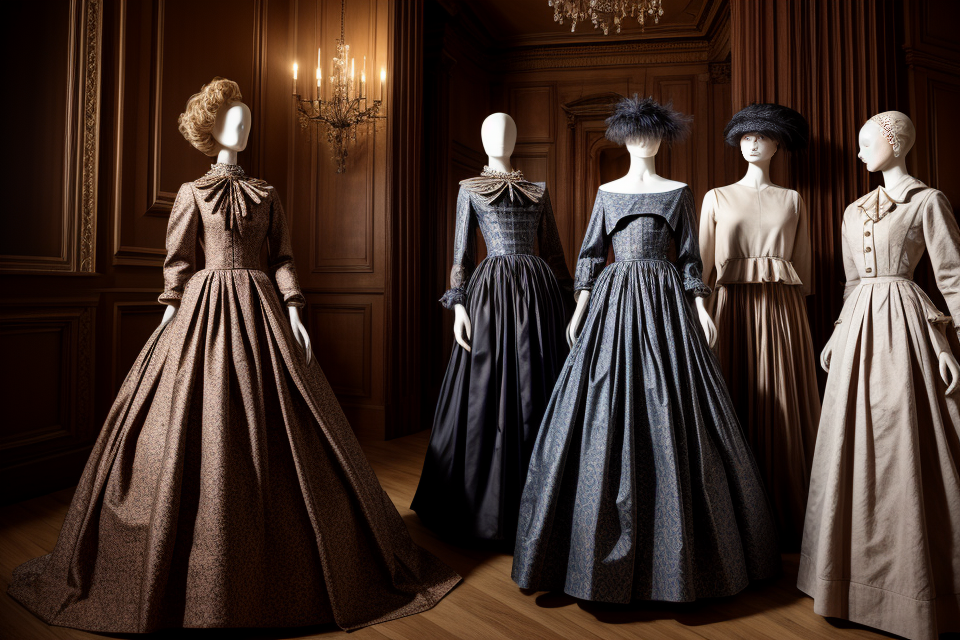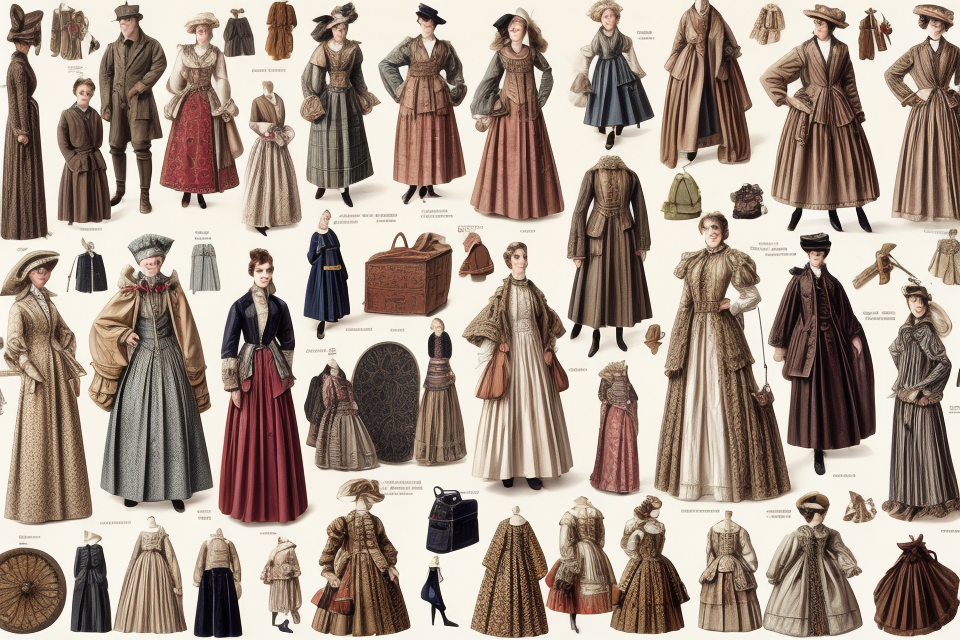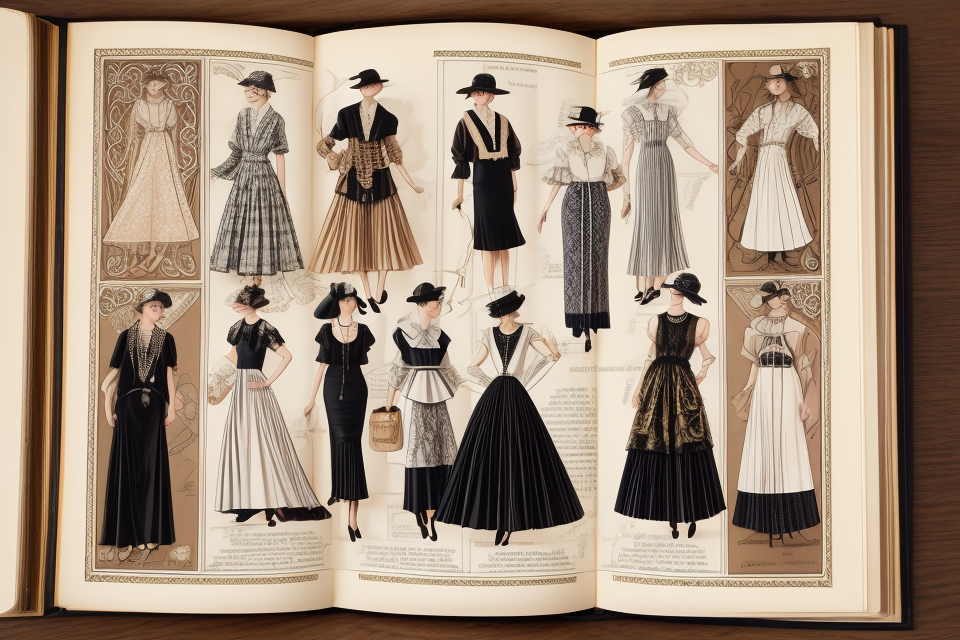
==========================================================================
When did fashion really start? This is a question that has puzzled many for centuries. Some believe that fashion began with the first clothes made by our ancestors, while others argue that it started with the rise of civilization. In this article, we will delve into the history of fashion and explore how it has evolved over time. From ancient civilizations to modern times, we will take a deep dive into the world of fashion and uncover its fascinating past. So, let’s get started and discover when fashion really began!
The history of fashion is a long and complex one, with roots dating back to ancient civilizations. However, the modern fashion industry as we know it today began to take shape in the 19th century, with the rise of mass production and the emergence of department stores. This allowed for clothing to be produced on a larger scale and made more widely available to the general public. In the 20th century, fashion became more influenced by popular culture and celebrities, and the industry continued to grow and evolve. Today, fashion is a global industry worth billions of dollars, and it continues to play a significant role in shaping our culture and identity.
The Roots of Fashion: Ancient Civilizations
The origins of fashion can be traced back to ancient civilizations, where clothing and adornment served not only as a means of protection from the elements but also as a form of self-expression and social status.
Egypt
In ancient Egypt, clothing was a symbol of power and wealth. The pharaohs and their courtiers wore elaborate jewelry, headdresses, and robes adorned with precious gems and metals. The common people, on the other hand, wore simpler garments made of linen or cotton.
Greece
Ancient Greek clothing was designed to be functional and comfortable, with loose-fitting tunics and cloaks made of wool or linen. Greek women also wore elaborate headdresses and jewelry, while men often adorned themselves with wreaths of leaves or flowers.
Rome
Roman clothing was heavily influenced by the Greeks, with tunics and cloaks being the primary garments. The rich and powerful wore luxurious fabrics and ornate jewelry, while the lower classes wore simpler clothing made of rougher materials.
Overall, ancient civilizations viewed clothing as a symbol of social status and power, with the wealthy and powerful adorning themselves with elaborate jewelry and garments made of fine materials. As civilizations developed and evolved, so too did fashion, with new styles and trends emerging throughout history.
Ancient Egypt
In ancient Egypt, clothing played a significant role in society, reflecting the hierarchy and social status of individuals. Clothing was not only a practical necessity but also a form of art and expression. The different types of clothing worn by various social classes, along with the role of clothing in religious rituals and ceremonies, provide a unique insight into the fashion of this ancient civilization.
The Importance of Clothing in Ancient Egyptian Society
Clothing in ancient Egypt was not merely a functional garment but a symbol of social standing, wealth, and status. The way one dressed indicated their occupation, wealth, and social position. The Pharaohs and other high-ranking officials were often depicted in elaborate clothing, while commoners wore simpler, more functional attire.
Different Types of Clothing Worn by Various Social Classes
Ancient Egyptian clothing varied depending on social class and occupation. Peasants and laborers typically wore loincloths or simple linen garments, while nobles and officials wore more elaborate outfits. Women’s clothing was often more elaborate than men’s, with elaborate headdresses and jewelry. The rich and powerful were often depicted in elaborate costumes and headdresses, adorned with precious gems and metals.
The Role of Clothing in Religious Rituals and Ceremonies
Religion played a significant role in ancient Egyptian society, and clothing was an essential part of religious rituals and ceremonies. Priests and priestesses often wore special robes and headdresses during religious ceremonies, reflecting their role in the community. In addition, clothing was often used to depict gods and goddesses in art and sculpture, reflecting the importance of fashion in religious expression.
Overall, the fashion of ancient Egypt reflects the rich history and culture of this fascinating civilization. From the practical necessity of clothing to its use as a symbol of status and power, ancient Egyptian fashion provides a unique insight into the fashion of this ancient civilization.
Ancient Greece
When it comes to the history of fashion, few civilizations have had as much impact as Ancient Greece. Greek mythology, with its tales of gods and heroes, has been a rich source of inspiration for designers, while the clothing worn by ancient Greeks provides important insights into the social and cultural norms of the time.
One of the most significant aspects of ancient Greek fashion was the role of clothing in society. In Greek culture, clothing was not simply a means of protection from the elements, but also a way of expressing one’s social status, occupation, and even political beliefs. For example, citizens of Athens were required to wear a simple, plain tunic as a symbol of their democratic values, while those in the ruling class could afford more elaborate and decorative clothing.
Ancient Greek clothing was also highly gendered, with men and women wearing different types of garments. Men typically wore a chiton, a long, sleeveless tunic that was fastened at the shoulder, along with a himation, a cloak that was draped over the chiton. Women, on the other hand, wore a peplos, a loose-fitting garment that was draped over the body and fastened at the shoulders, along with a himation or a chiton. The peplos was often adorned with intricate embroidery or other decorative elements.
Greek mythology also had a significant impact on ancient Greek fashion. Many of the gods and goddesses were depicted wearing elaborate, decorative garments, and their stories often provided inspiration for the designs of mortal Greeks. For example, the goddess Athena was often depicted wearing a Corinthian helmet, a long, sleeved tunic, and a himation, while the goddess Aphrodite was often shown wearing a diaphanous robe.
Overall, the fashion of ancient Greece provides an important window into the social, cultural, and even mythological influences that have shaped the history of style. By examining the clothing worn by ancient Greeks, we can gain a better understanding of the role that fashion has played in human society throughout history.
Ancient Rome
The role of clothing in Roman society and culture
Clothing played a significant role in Roman society and culture, serving as a symbol of social status, political power, and cultural identity. The way one dressed conveyed one’s position in society, and there were strict rules and regulations governing the attire of different social classes. For example, only citizens were allowed to wear the toga, a long, flowing garment that was the symbol of Roman citizenship.
The influence of Roman fashion on modern fashion
Despite the fact that the Roman Empire has been gone for over 1,500 years, its influence on fashion is still evident today. The classic Greek and Roman styles have inspired designers and fashion houses for centuries, with the draped dresses and togas of ancient Rome being particularly influential. Even the modern business suit can be traced back to the toga, with its long, flowing lines and formal elegance.
The different types of clothing worn by men and women
In ancient Rome, men and women wore different types of clothing that reflected their social and cultural roles. Men typically wore a tunic, a piece of clothing that was similar to a long shirt, which was often worn over a pair of pants. Over the tunic, men would wear a cloak or toga, which was a long, flowing garment that was typically made of wool or linen. Women, on the other hand, wore a variety of different clothes, including tunics, dresses, and stolas, which were a type of wrap-around garment.
The Middle Ages: From the Dark Ages to the Renaissance
============================================================
The Middle Ages, spanning from the 5th to the 15th century, was a period of significant cultural, social, and political change. It was during this time that fashion began to evolve and take on new forms, reflecting the shifting values and ideals of society.
The Dark Ages
The Early Middle Ages, also known as the Dark Ages, saw the collapse of the Roman Empire and the emergence of new kingdoms and cultures. During this time, fashion was relatively simple and functional, with people primarily focused on practical clothing for survival.
- Clothing was primarily made from wool, linen, and leather
- Commoners wore simple tunics and trousers, while nobles wore more elaborate clothing
- Headwear was minimal, with men typically wearing baldrics or caps, and women wearing veils or wimples
The Renaissance
The Late Middle Ages saw the emergence of the Renaissance, a period of cultural and artistic renewal. Fashion during this time became more ornate and extravagant, reflecting the growing wealth and power of the European states.
- Fashion became more diverse, with different regions developing their own styles
- Silk, velvet, and other luxury fabrics became more widely available
- Men’s fashion featured doublets, hose, and elaborate hats, while women’s fashion included elaborate headdresses, corsets, and farthingales
The Renaissance also saw the rise of the “Fashion Plate,” the first known depictions of fashionable clothing in printed form. These illustrations, featured in publications such as The Book of Hours and The Fashionable Lives of the Ladies of Great Britain, were instrumental in spreading fashion trends across Europe.
In conclusion, the Middle Ages were a period of significant change in fashion, as society shifted from the practical clothing of the Dark Ages to the ornate and extravagant styles of the Renaissance. The emergence of the Fashion Plate was a key moment in the history of fashion, and set the stage for the development of fashion as a global industry in the centuries to come.
The Dark Ages
- The Lack of Fashion during the Dark Ages
During the Dark Ages, fashion as we know it today did not exist. This period, which lasted from the 5th to the 15th century, was characterized by a lack of a centralized authority, economic instability, and social unrest. As a result, there was no need for fashion, as people were more concerned with survival than with appearances. - The Influence of the Catholic Church on Clothing
The Catholic Church played a significant role in shaping the way people dressed during the Dark Ages. The Church’s teachings emphasized modesty and humility, and this was reflected in the simple and plain clothing worn by the clergy and the faithful. The Church also enforced dress codes, requiring people to wear specific clothing to attend religious services. - The Importance of Clothing in Medieval Society
Although fashion was not a significant aspect of life during the Dark Ages, clothing was still important in medieval society. Clothing served as a symbol of social status, with the wealthy wearing more expensive and elaborate clothing than the poor. Additionally, clothing was used to denote religious affiliation, with the clergy wearing distinctive garments to identify themselves as members of the Church.
The Renaissance
The Renaissance, which lasted from the 14th to the 17th century, was a period of great cultural and artistic development in Europe. This period marked the rebirth of classical ideas and values, and it had a profound impact on the world of fashion.
The Rebirth of Fashion during the Renaissance
During the Renaissance, there was a renewed interest in classical Greek and Roman art and culture. This led to a revival of the classical ideals of beauty and proportion, which in turn influenced the way people dressed. Clothing became more form-fitting and emphasized the natural shape of the body, rather than the previous century’s loose and billowy styles.
The Influence of Artists and Writers on Fashion
Artists and writers of the Renaissance played a significant role in shaping fashion trends. Many artists, such as Leonardo da Vinci and Michelangelo, depicted figures in their paintings wearing the latest styles, which helped to popularize new fashion trends. Writers, such as Baldassare Castiglione, also wrote about fashion and its importance in society. His book, “The Book of the Courtier,” provided guidance on how to dress and behave at court, and it became a bestseller throughout Europe.
Different Types of Clothing Worn by Men and Women
During the Renaissance, men and women’s clothing became more distinct from one another. Men began to wear suits consisting of a doublet (a close-fitting jacket) and breeches (tight-fitting trousers), while women’s dresses became more elaborate and decorated. Women also began to wear high-necked blouses called ruffs, which were made of lace or linen. The ruff was a symbol of social status and wealth, as it was a expensive to produce and maintain.
The Modern Era: From the Industrial Revolution to Today
The modern era of fashion began during the Industrial Revolution in the 18th century. With the advent of mass production, clothing became more widely available and affordable, leading to a shift in fashion trends. The industrial revolution also saw the rise of fashion magazines and newspapers, which helped to spread fashion trends and ideas across the globe.
During the 19th century, fashion became more about status and class, with the upper class dictating the trends that the lower classes would follow. The introduction of ready-to-wear clothing during this time made fashion more accessible to the masses, but it also led to a homogenization of style.
The 20th century saw a shift towards more individual expression and self-expression through fashion. The rise of Hollywood and celebrity culture helped to popularize certain fashion trends, while the 1960s and 1970s saw a shift towards more bohemian and counterculture styles.
Today, fashion is a global industry worth billions of dollars, with designers, retailers, and consumers all playing a role in shaping the trends of the moment. With the rise of social media and e-commerce, fashion is more accessible than ever before, but it is also more fragmented and difficult to predict.
The Industrial Revolution
- The Impact of the Industrial Revolution on Fashion
- The shift from handmade to machine-made clothing
- The rise of mass production and the availability of ready-to-wear clothing
- The impact on the fashion industry and the working class
- The Rise of Mass Production and the Availability of Ready-to-Wear Clothing
- The emergence of factories and the use of machinery
- The growth of the textile industry
- The increase in demand for clothing and the need for standardization
- The Influence of Fashion Magazines and Newspapers
- The role of fashion media in shaping public opinion
- The rise of fashion journalism and the importance of fashion critics
- The impact of fashion magazines and newspapers on the fashion industry and consumer behavior.
The 20th Century
The Different Fashion Trends of the 20th Century
The 20th century was a time of great change and transformation in the world of fashion. From the flapper dresses of the Roaring Twenties to the miniskirts of the Swinging Sixties, the fashion trends of the 20th century reflected the social, political, and cultural shifts that occurred during this time.
Some of the most notable fashion trends of the 20th century include:
- The Roaring Twenties: During this era, fashion was characterized by a sense of liberation and experimentation. Women embraced a more androgynous style, adopting short bob haircuts and boyish clothing. Meanwhile, men began to abandon their traditional suits and ties in favor of more casual attire.
- The Great Depression: The economic downturn of the 1930s had a significant impact on fashion. With many people struggling to make ends meet, fashion became more practical and utilitarian. Women’s dresses became simpler and more functional, while men’s clothing was often made from recycled materials.
- The 1940s: During World War II, fashion was heavily influenced by the need for practicality and functionality. Women’s dresses were designed to be easier to move in and to use less fabric, while men’s clothing was often made from military surplus materials.
- The 1950s: The 1950s saw a return to more traditional fashion styles, with women’s dresses becoming more feminine and voluminous. Meanwhile, men’s fashion continued to be influenced by military styles, with many men wearing tailored suits and button-up shirts.
- The 1960s: The 1960s was a time of great change and experimentation in fashion. Women embraced a more youthful and playful style, adopting miniskirts and other revealing clothing. Meanwhile, men’s fashion became more casual and relaxed, with the rise of jeans and T-shirts.
The Influence of Celebrities and Film Stars on Fashion
Throughout the 20th century, celebrities and film stars had a significant impact on fashion trends. From Marilyn Monroe to Audrey Hepburn, these iconic figures were often seen as fashion trailblazers, setting the tone for the styles of the time.
Monroe, for example, was known for her curves and her love of pink, white, and black. Her signature style – a fitted top and full skirt – became known as the “Marilyn Monroe look.” Similarly, Hepburn’s classic, elegant style – including her famous little black dress – continues to influence fashion to this day.
Other celebrities and film stars who had a significant impact on fashion during the 20th century include Elizabeth Taylor, Grace Kelly, and Jackie Kennedy.
The Impact of the Internet and Social Media on Fashion
The rise of the internet and social media in the latter half of the 20th century had a profound impact on the fashion industry. For the first time, people had access to a vast array of fashion information and images from around the world. This allowed for the spread of fashion trends and ideas on an unprecedented scale.
In addition, social media platforms like Instagram and TikTok have given rise to a new generation of fashion influencers and bloggers, who have the power to shape trends and dictate what is “cool” or “on-trend.” These influencers often have millions of followers, and their opinions and recommendations can have a significant impact on the fashion choices of their followers.
Overall, the 20th century was a time of great change and transformation in the world of fashion. From the flapper dresses of the Roaring Twenties to the miniskirts of the Swinging Sixties, the fashion trends of the 20th century reflected the social, political, and cultural shifts that occurred during this time. And with the rise of the internet and social media, the influence of celebrities and film stars, and the continuing evolution of fashion trends, it’s clear that the
The 21st Century
The rise of sustainable and ethical fashion
The 21st century has seen a growing awareness of the environmental and social impact of the fashion industry. This has led to the rise of sustainable and ethical fashion, which prioritizes the use of eco-friendly materials and fair labor practices. Consumers are becoming more conscious of the environmental impact of their purchases, and many are seeking out brands that align with their values.
The influence of streetwear and athleisure on fashion
Streetwear and athleisure have had a significant influence on fashion in the 21st century. Streetwear, which originated in California in the 1970s, is a style that blends sportswear with urban fashion. Athleisure, on the other hand, is a trend that combines athletic clothing with everyday wear. Both styles have become increasingly popular in recent years, with many fashion brands incorporating elements of streetwear and athleisure into their collections.
The impact of the pandemic on fashion
The COVID-19 pandemic has had a significant impact on the fashion industry, with many brands forced to shut down stores and cancel events. The pandemic has also led to a shift in consumer behavior, with many people opting for comfortable and practical clothing. This has led to an increase in demand for athleisure and loungewear, as well as a trend towards more comfortable and versatile footwear. The pandemic has also accelerated the shift towards online shopping, with many consumers turning to e-commerce platforms to make their purchases.
FAQs
1. When did fashion really start?
The history of fashion is a long and complex one, with roots dating back to prehistoric times. However, the modern concept of fashion as we know it today began to take shape in the 14th century, during the Renaissance period. It was during this time that fashion began to be seen as a form of self-expression and a way to show social status.
2. Who were the first fashion designers?
The concept of fashion design as we know it today did not exist in ancient times. Instead, clothing was created by individual craftsmen and tailors who specialized in specific techniques and styles. The first recognized fashion designers as we know them today emerged in the 19th century, with names like Charles Worth and Coco Chanel leading the way.
3. How has fashion evolved over time?
Fashion has undergone significant changes over the centuries, with different styles and trends emerging and falling out of favor. In the 18th and 19th centuries, fashion was heavily influenced by the French court and the aristocracy. In the 20th century, fashion became more democratic, with designers and magazines playing a greater role in shaping trends. Today, fashion is a global industry that is constantly evolving and adapting to changing social and cultural norms.
4. What are some of the most iconic fashion moments in history?
There have been many iconic fashion moments throughout history, from the corseted dresses of the 18th century to the miniskirts of the 1960s. Some of the most memorable moments include the first appearance of Coco Chanel’s little black dress in 1926, the emergence of the Beatles’ moptop haircuts in the 1960s, and the launch of the first Versace collection in 1993.
5. How has technology impacted the fashion industry?
Technology has had a profound impact on the fashion industry, from the creation of fabrics and materials to the design and production process. Advances in digital technology have made it possible to create virtual fashion shows and launch collections online, while social media has transformed the way designers and brands interact with consumers.


